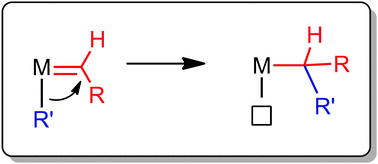Carbene insertion into transition metal–carbon bonds: a new tool for catalytic C–C bond formation
Abstract
In this perspective we highlight the applicability of migratory

* Corresponding authors
a
Van't Hoff Institute for Molecular Sciences (HIMS), Department of Homogeneous and Supramolecular Catalysis, Universiteit van Amsterdam, P. O. Box 94720, 1090 GS Amsterdam, The Netherlands
E-mail:
B.deBruin@uva.nl
Fax: +31 20 525 5604
Tel: +31 20 525 6495
b Dutch Polymer Institute DPI, P. O. Box 902, 5600 AX Eindhoven, The Netherlands
In this perspective we highlight the applicability of migratory

 Please wait while we load your content...
Something went wrong. Try again?
Please wait while we load your content...
Something went wrong. Try again?
N. M. G. Franssen, A. J. C. Walters, J. N. H. Reek and B. de Bruin, Catal. Sci. Technol., 2011, 1, 153 DOI: 10.1039/C0CY00065E
To request permission to reproduce material from this article, please go to the Copyright Clearance Center request page.
If you are an author contributing to an RSC publication, you do not need to request permission provided correct acknowledgement is given.
If you are the author of this article, you do not need to request permission to reproduce figures and diagrams provided correct acknowledgement is given. If you want to reproduce the whole article in a third-party publication (excluding your thesis/dissertation for which permission is not required) please go to the Copyright Clearance Center request page.
Read more about how to correctly acknowledge RSC content.
 Fetching data from CrossRef.
Fetching data from CrossRef.
This may take some time to load.
Loading related content
